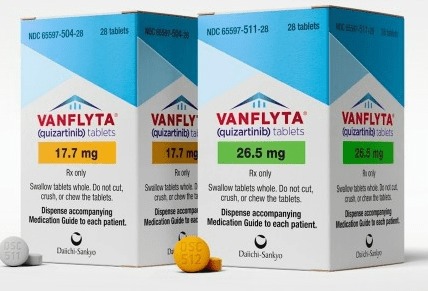August 2023: The treatment of adult patients with newly diagnosed acute myeloid leukaemia (AML) that is FLT3 internal tandem duplication (ITD)-positive, as detected by an FDA-approved test, with standard cytarabine and anthracycline induction and cytarabine consolidation, as well as as maintenance monotherapy following consolidation chemotherapy, has been approved by the Food and Drug Administration.
LeukoStrat CDx FLT3 Mutation Assay was additionally given FDA approval as a Vanflyta companion diagnostic.
In QuANTUM-First (NCT02668653), a randomised, double-blind, placebo-controlled trial involving 539 patients with newly diagnosed FLT3-ITD positive AML, the effectiveness of quizartinib in combination with chemotherapy was assessed. A clinical trial assay was used to establish the FLT3-ITD status prospectively, and the companion diagnostic LeukoStrat CDx FLT3 Mutation Assay was used to confirm it after the fact.
According to the initial assignment, patients were randomised (1:1) to receive quizartinib (n = 268) or a placebo (n = 271) with induction, consolidation, and maintenance monotherapy. At the start of post-consolidation therapy, there was no re-randomization. After hematopoietic stem cell transplantation (HSCT) recovery, patients who underwent HSCT started maintenance therapy.
Overall survival (OS), calculated from the randomization date until death from any cause, served as the primary efficacy outcome measure. After at least 24 months had passed since the final patient was randomly assigned, the major analysis was carried out. In the trial, the quizartinib arm showed a statistically significant increase in OS [hazard ratio (HR) 0.78; 95% CI: 0.62, 0.98; 2 sided p=0.0324]. With a median duration of 38.6 months (95% CI: 21.9, NE), the quizartinib arm’s CR rate was 55% (95% CI: 48.7, 60.9), and the placebo group’s CR rate was 55% (95% CI: 49.2, 61.4) with a median duration of 12.4 months (95% CI: 8.8, 22.7).
Following allogeneic HSCT, quizartinib is not recommended as maintenance monotherapy. Quiartinib has not been shown to increase OS in this situation.
QT prolongation, torsades de pointes, and cardiac arrest are all mentioned in the boxed warning for quizartinib. Only the Vanflyta REMS, a restricted programme under a Risk Evaluation and Mitigation Strategy (REMS), offers quizartinib. For a comprehensive list of side effects, consult the prescribed information.
The recommended quizartinib dose is as follows:
- Induction: 35.4 mg orally once daily on Days 8-21 of “7 + 3” (cytarabine [100 or 200 mg/m2/day] on Days 1 to 7 plus daunorubicin [60 mg/m2/day] or idarubicin [12 mg/m2/day] on Days 1 to 3) and on Days 8-21 or 6-19 of an optional second induction (“7 + 3” or “5 + 2” [5 days cytarabine plus 2 days daunorubicin or idarubicin], respectively),
- b) Consolidation: 35.4 mg orally once daily on Days 6-19 of high‑dose cytarabine (1.5 to 3 g/m2 every 12 hours on Days 1, 3 and 5) for up to 4 cycles, and
- c) Maintenance: 26.5 mg orally once daily on Days 1 to 14 and 53 mg once daily, thereafter, for up to thirty-six 28-day cycles.
View full prescribing information for Vanflyta


